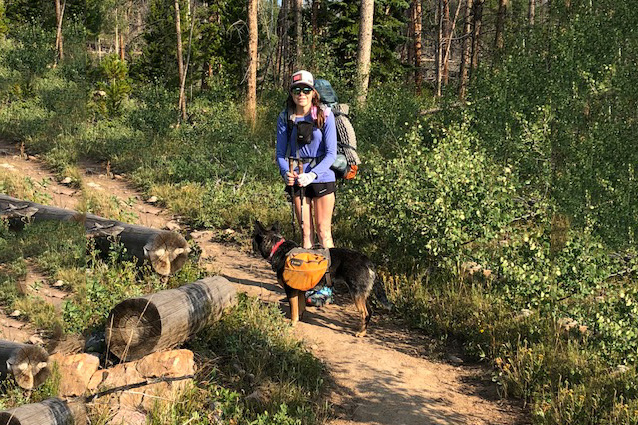Dogs can go darned near everywhere with us — even on a thru-hike. But, just like humans, they require some TLC to ramble on and on.
Meet Lola, a 5-year-old Australian cattle dog. We recently highlighted her in a story about canines that could benefit from pet fitness trackers.
After backpacking with her owner over the 165-mile Tahoe Rim Trail, across 220 miles of the Pacific Crest Trail, and adventuring every weekend hiking or backcountry skiing in Northern Tahoe, Lola collapsed 145 miles into the Colorado Trail.
She wasn’t hurt; she was just exhausted, and maybe dehydrated or her fueling was off. Or she was getting older. She looked happy and healthy right up to the moment she lay down in the dirt and declined to get up.
Nancy East, a veterinarian and blogger who hikes regularly with her dog in North Carolina, says that’s not uncommon.
“Dogs want to keep up with their owners and oftentimes hike slightly ahead. If your dog is lagging behind, panting excessively, foaming saliva, lying down on the trail, and/or seeking shade, it’s time for some water and rest.”

Tips for Thru-Hiking With Your Dog
Dogs can’t communicate about what’s wrong. So pet owners need to be responsible when taking dogs off the grid. You can’t expect them to trudge days on end through the wild without some planning and training.
Just like you prepare for your own backpacking trip by minding food, gear, and weight requirements, your dog deserves the same attention. Here are a few things to keep in mind.
Know your breed.
Lola is a cattle dog with seemingly endless energy and drive to go just about anywhere with her owner. But not all dogs are genetically inclined to work like that. And even Lola had her limits.
There’s tremendous variability in individual dogs and their overall health. “Even if you have a dog you think might be well suited for long-distance hiking, it’s imperative to get your veterinarian’s thoughts on your dog’s health and breed-related risk factors,” said East.
That said, some specific breeds like pugs, bulldogs, and Boston terriers won’t make good thru-hiking companions. These breeds have compressed facial anatomy, which means they have difficulty breathing even in normal circumstances. A thru-hike could put them in distress.
Before you go.
Don’t forget to make sure your dog is on intestinal parasite, flea, and tick prevention as well as up to date on vaccines, including leptosprirosis, which is usually acquired via water or soil that has been contaminated from the urine of wildlife shedding the bacteria.
If you will be hiking in an area where there are deer ticks, which carry Lyme disease, East said to have your dog vaccinated for Lyme as well.
Start in puppyhood.
Like humans, dogs can train to go further and do more. If you’re planning to take your dog on an extended adventure, start with short but regular hikes during puppyhood and build up.
Slowly add a pack, and have your dog carry a portion of its own weight (see below). Give your young dog adequate time to build muscle, stamina, and pad protection for backpacking. Take your dog on all your own training hikes in advance of a big trip.
And don’t overlook basic obedience training to make sure Fido is friendly on the trail. “Having voice command over your dog is imperative to a safe hiking experience,” East said. “Likewise, dogs should be kept on leash at all times, both for safety reasons and to avoid encounters with other hikers who may not appreciate a close encounter with your furry friend.”
If you will be hiking in rattlesnake country, you can even enroll your dog in rattlesnake-avoidance training. East said that because dogs are usually naturally curious, and sometimes even prone to aggression, when they encounter snakes, this can be a good preventative measure.
Invest in the right pack.
Dogs can safely carry their own food and first aid. Start by getting a properly fitting backpack for your dog. They vary widely, just like the size and structure of your dog. This pack should be able to carry food, leash, and doggie first aid.
Lola’s stash includes gauze, vet wrap, wound wash, eye wash, and a simple corded leash. East also regularly recommends that owners carry doggie Benadryl in the event of a bee sting or snake bite.
Train slowly — not speed hiking — with your pack-strapped dog before a bigger adventure. Test the pack on several training walks and watch for potential rub areas. Remember, your buddy won’t point out a sore spot.
Balance the load.
Keeping your dog’s pack load balanced is important. But even more critical is making sure the load is at or under 10-12 percent of your pup’s body weight. Some dogs can happily carry more, but this is a safe range that won’t add undue stress or cause an injury.
This also means you may be carrying some of your dog’s food. For example, Lola can carry enough for about four days before a resupply.
Experiment with backcountry food.
Dogs have increased nutritional needs during a backpacking trip. To walk for miles, they need calories, carbs, and plenty of protein to fuel.
Lola, for example, eats Instinct dog food on the daily. For big backpacking trips, she carries a higher-protein-content bag of the same brand. She also gets a protein-packed raw treat each hiking day.
But fully grain-free food is not necessary, according to East, unless your dog has a known food allergy to grains. “Carbohydrates are just as important for dogs as they are for you during periods of high activity,” she said.
Dehydrated dog food is another option. East’s favorite is Honest Kitchen, made with human-grade ingredients in a variety of flavors that are all highly palatable when reconstituted with water.
Pay attention to pads and paws.
Dogs’ pads are not as tough as they look. They need to get used to longer distances but also varied hiking surfaces. This is especially important if you live in the city and your dog is used to playing on pavement. Pads will wear down quickly on rock and trail and become sore and painful. That’s game over on an adventure.
Each night after setting up camp, put salve on your dog’s pads. That’s one simple way to extend their life. Musher’s Secret wax is a favorite among hikers.
You can also try booties or shoes, especially if your urban companion isn’t used to walking on uneven surfaces or scree like shale and granite. Many dogs will kick these off at first, but don’t give up after one try. Booties can be lifesavers both on the trail and snow.
“It’s a good idea to ease your dog into the idea of wearing booties,” East said. “Try some practice runs at home, so it’s not a completely new and stressful experience on the trail when and if they are needed.”
Think about bailouts.
Once you start going longer, continue to play it safe by route planning your thru-hike with some bailout options. For example, because of Lola’s breakdown, the Colorado Trail trek got cut well short. She needed to get out of the backcountry.
This is also important in the case of injury or if dog food is lost or eaten. Make smart decisions for backcountry travel just like you would for yourself.
Add a couple creature comforts.
Dogs are animals. But they’re working hard on a thru-hike — just like their humans. So stashing a few essentials that will speed your dog’s overnight recovery sesh will make you both happier campers.
Lola has her own jacket that can keep her warm at night. She also has a thin, body-size foldable mat to keep her warm, dry, and her worn-out joints up off the ground at night.
East also suggests a nightcap snack: “Similar to humans, a small snack before bedtime can be helpful in keeping a dog warm through the night.”
Ramp up downtime.
Dogs require a very long recovery time after a big physical exertion — even longer than what humans need. That equates to a lot of sleep and rest following a multiday trek. Because dogs age so rapidly, longer thru-hikes or backpack trips get harder on them each year.
Most importantly, know your dog. Before you go, learn your companion’s energy level and mileage comfort, food requirements to maintain weight, and ability to cope in extreme weather.
And remember that all these things shift with each passing year. Stay attuned to your dog so you can share the long road of adventuring ahead.












